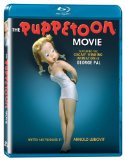| Reviews & Columns |
|
Reviews DVD TV on DVD Blu-ray 4K UHD International DVDs In Theaters Reviews by Studio Video Games Features Collector Series DVDs Easter Egg Database Interviews DVD Talk Radio Feature Articles Columns Anime Talk DVD Savant Horror DVDs The M.O.D. Squad Art House HD Talk Silent DVD
|
DVD Talk Forum |
|
|
| Resources |
|
DVD Price Search Customer Service #'s RCE Info Links |
|
Columns
|
|
|
Puppetoon Movie, The
Celebrating George Pal's mostly-forgotten animated legacy
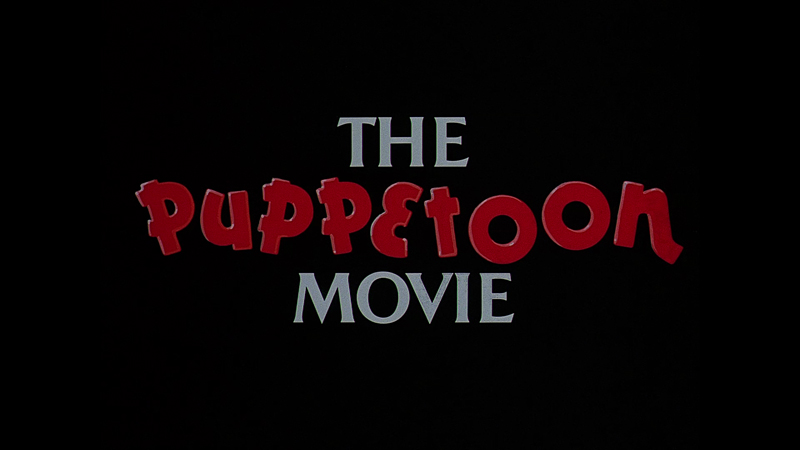
Loves: Animation
Likes: Davey & Goliath, Gumby, Historical collections that don't ignore controversy
Dislikes: Most puppets
Hates: How artists oft go unappreciated
The Movie
Though I consider myself film literate, before watching this set, the extent of my knowledge of George Pal was limited to the reference to his name in the lyrics of "Science Fiction Double Feature," from the glorious musical Rocky Horror Picture Show: "But when worlds collide, said George Pal to his bride, I'm gonna give you some terrible thrills." The thing is, I actually was somewhat aware of his work, having been a fan of The Time Machine and having watched a few of his productions. I just didn't connect the name with the films. However, I had no connection to his Puppetoons shorts, all of which had their heyday well before I arrived on the scene. That said, his influence reached me through the work of Ray Harryhausen and the stop-motion animation I enjoyed as a child.
His Puppetoons are true works of art, blending the stylized artistry of cartoons with the dimensionality of live-action film through a series of wooden puppets that are manipulated to tell a story. The effect created something wholly unique that made the fantastic tangible. A European ex-pat who escaped the rise of Adolph Hitler, he found his fortune in America, becoming a friend and rival to the great Walt Disney by taking the innovative technique he created for commercials and applying it in the world of short subjects (and, eventually, feature films.) One man who refused to let his legacy die was Arnold Leibovit, who gathered together a handful of Pal's best works and wrapped them in new stop-motion bookends (featuring Gumby and Pokey, along with a host of Pal creations and those of creators he influenced) to create The Puppetoon Movie.
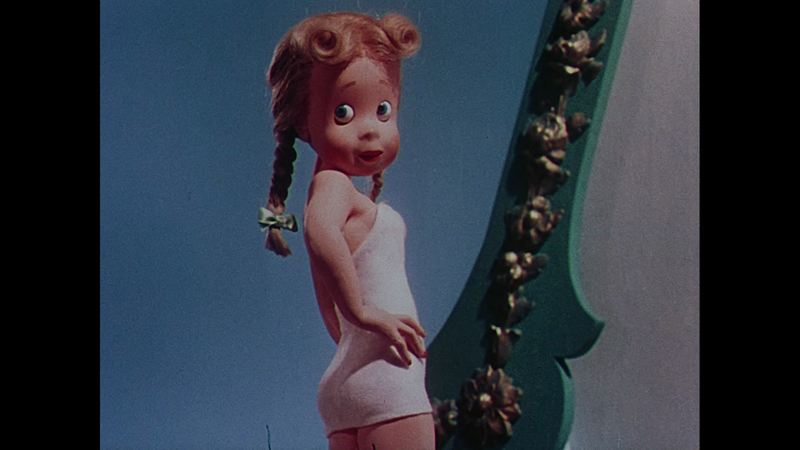
The shorts represent a wide swatch of Pal's work, including his fairy tales, his musicals and his political work, like the wonderful Tulips Shall Grow, a short about the Nazi invasion of Holland. Thankfully, this film doesn't ignore the less savory side of Pal's work from a less enlightened time, which gave us his Jasper cartoons, about a young black child and his battles with a mean scarecrow, which are notable for their use of racial stereotypes that were acceptable at the time. Often this kind of material is left out of retrospectives, but Jasper's popularity is explored via a clip from Jasper in a Jam. An attempt is made to excuse Pal's use of stereotypes and racist imagery by balancing it with the inclusion of his acclaimed adaptation of the John Henry legend, perhaps his most cinematic Puppetoon ever.
The downsides here are a lack of narrative or insight, as the voice of an expert would be appreciated, as well as the length, as the lack of a storyline leaves it with no pacing of any kind. That's where having it on Blu-ray is so great, as you can jump around as you desire, avoiding a potential slog through the film's lesser lights, like the two Philips commercials. That's the thing about this collection. The fact that the shorts are presented separately in full is the real reason to want to own this movie, as if the main feature is really the extra.
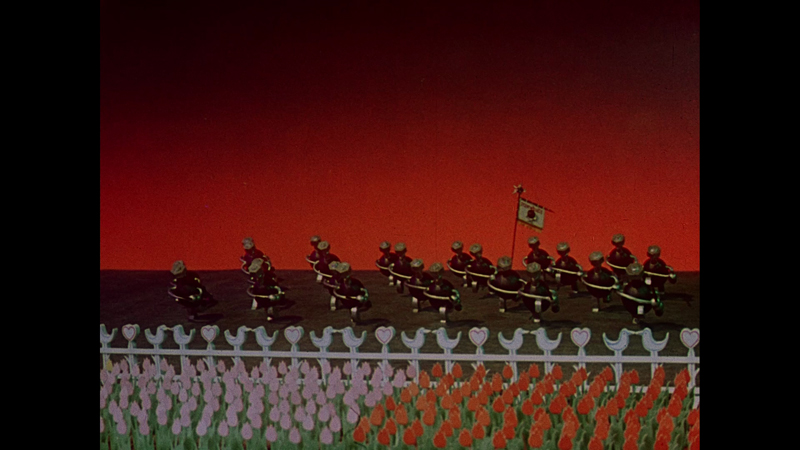
The Discs
The Puppetoon Movie arrives in a two Blu-Ray set, which are packed in a standard-width, dual-hubbed Blu-ray keepcase with a six-page booklet. The static menus offer the choice to watch the film, select scenes, adjust the set-up and check out the special features. Audio options include English 4.0 DTS-HD Master Audio and 2.0 LPCM Stereo, though there are no subtitles.
The Quality
Delivered in a 1080p, AVC-encoded full-frame transfer (with pillar-boxing), the film looks great for its age, with appropriate color, deep black levels and a strong level of fine detail, showing off all the textures in the puppets. The film didn't get much, if any clean-up, so you'll see dirt, damage and a few hairs here and there (possibly aided by the clarity of the transfer) though there are no obvious issues with compression artifacts. Any expectations you have for little-known short films from the ‘30s and ‘40s should be blown clear away.
Getting a 4.0 DTS-HD Master Audio track was a new one, but the presentation is clear and clean, even if it doesn't take much advantage of the extra channels (not that the material ever would have anyway.) Nothing sounded out of place, and the music was nice and strong throughout.
The Extras
The key extra is a new feature-length audio commentary by Leibovit and animation expert Jerry Beck. Obviously Leibovit has plenty to say, due to his intimate knowledge of the film and Pal's work, while Beck's universal knowledge of animation lets him chime in to great effect, as they cover Pal's technique and process in detail, as well as talking about this film's origins and the work done on the movie (though it never gets too screen specific.) Pal's influences on filmmakers and the elements of race and politics in his work are reviewed as well, making it an excellent overview of Pal's filmmaking.
A selection of seven high-definition Puppetoon shorts from across Pal's career are offered (with a play-all option), including:
- Rhythm in the Ranks (9:59)
- The Sky Princess (7:33)
- The 500 Hats of Bartholomew Cubbins (8:53)
- And to Think That I Saw it on Mulberry Street (7:21)
- Jasper and the Beanstalk (7:45)
- A Date with Duke (7:39)
- Rhapsody in Wood (9:15)
- What Ho She Bumps (7:41)
- Mr. Strauss Takes a Walk (7:42)
- Olio for Jasper (7:59)
- Philips Cavalcade (5:42)
- Jasper's Derby (8:46)
- Hoola Boola (8:50)
- Ether Symphony (8:12)
- Aladdin and the Magic Lamp (4:40)
- The Magic Atlas (7:40)
- Jasper and the Haunted House (6:58)
- The Philips Broadcast of 1938 (5:11)
- The Ship of the Ether (7:21)
The Fantasy Film Worlds of George Pal is a standard-definition, feature-length (93:30) look at the man's work, from animation through feature films, full of clips and interviews with his contemporaries, including Tony Curtis, Joe Dante, Barbara Eden, Charleton Heston, Walter Lantz, Tony Randall and many, many others. Though a bit by the numbers, there's little from Pal's career that isn't covered here, making it a fine companion piece to the Puppetoons content.
Trailers are included for The Puppetoon Movie (1:51) and The Fantasy Film World of George Pal (3:57), while a 4:43 automatic slideshow titled "Production Still Gallery" shows some great on-set photos of Pal from his various films, along with sketches, posters and billboards,
"Reminiscing with Puppetoon Animator Bob Baker" spends 12:53 with the artist, who sits behind a pile of Pal's puppets, talking about the wooden creations and the process of making a Pal film. The key takeaway here is the chance to get a better look at the puppets and understand how the movies were actually made.
A second disc contains the rest of the bonus content, starting with a high-definition transfer of the 88-minute The Great Rupert. Better known by some as A Christmas Wish, this classic holiday comedy was produced by Pal and stars Jimmy Durante and Terry Moore (Mighty Joe Young). It's a bit odd in the context of Pal's most famous work or this set in particular, but it does feature Rupert, an animated squirrel done in Pal's signature style, which results in a rather creepy-looking rodent. Durante is in fine form as the family patriarch and Moore is a true ingenue, which makes for an entertaining film, while Rupert is an interesting novelty.
"Previously Unreleased Interviews," with Wah Chang, Roy Disney, Duke Goldstone, Ray Harryhausen, Gene Roddenberry, Ray Bradbury and Russ Tamblyn, runs a whopping combined 87:12, featuring footage that the interviews in The Fantastic Film Worlds. Tamblyn (whose 26:01 naturally focuses on his work on tom thumb) and Harryhausen (who discusses his history with Pal for 19:02) get the bulk of the screentime, though everyone talks for at least eight minutes (with the disappointing two minutes of Bradbury being the only exception.) There are some very interesting notes about Pal, especially from Roddenberry.
The trailer for Destination Moon (2:08) is available to check out, It's a classic old-school trailer, full of on-screen hyperbole and goofy moments from the movie, making it fun nostalgia. (For some reason, the trailers for The Fantasy Film World of George Pal and The Puppetoon Movie are repeated here as well.)
When the 8:35 "Disney Animator Ward Kimball Discusses His Relationship with George Pal and Walt Disney" started, I did a double take, as this elderly man is dressed in a silly fireman's outfit. He explains why, but it's still nutty. The focus here is Pal's love of jazz and the early Disney animators' interest in Pal's work, especially Disney himself.
The archival content starts with "KTLA City at Night on the Set of Destination Moon" a 22:30 program featuring the adorably soft-spoken and accented Pal, Though a touch dry, the feel is wonderfully awkward, unpolished and old-school (right down to the shameless smoking of cigarettes) though you can see the roots of today's vapid entertainment reporting in the two KTLA anchors. The footage and sound is a bit rough, but it's not too hard to watch, which is good, since the look at the film's giant sets is excellent.. The 5:54 "The Wonderful World of the Brothers Grimm Premiere Opening at the Indian Mills Cinerama Theater in Omaha, Nebraska," shot in 1962, is an even less polished local mid-West telecast. The gala opening includes an on-stage interview with Pal, who talks a bit about the film, and a tragically-injured young boy Pal surprises. Jumping ahead in time, and into color, "George Pal Discusses his Film The Power" (7:30) lets you hear a bit more from the filmmaker, as he discusses that film, his background and his famous puppets.The editing is a bit choppy, but it's pretty much pure Pal.
Up next, there's a pair of silent home movies, 1952's "The Pal Family in Las Cruces (Baja, CA)" (2:26) and 1933's "George Pal Outside of His Studio in Eindhoven, Holland" (:36). One features Pal and company showing off some massive swordfish they caught, while the more brief clip features some of Pal's puppets. Neither adds a lot, but their inclusion makes the set more complete.
There's another, longer slideshow with more on-set photos and some helpful captions as well. Some of the pictures are repeated from the previous gallery, but there's a decent amount of new material. The extras wrap with the very short "Wah Chang Hand Puppet" (:27), as the animator shows off an amazing hand puppet.
In the box is a booklet with a note from Leibovit and an essay by Beck that's something of a boiled-down text version of his commentary.
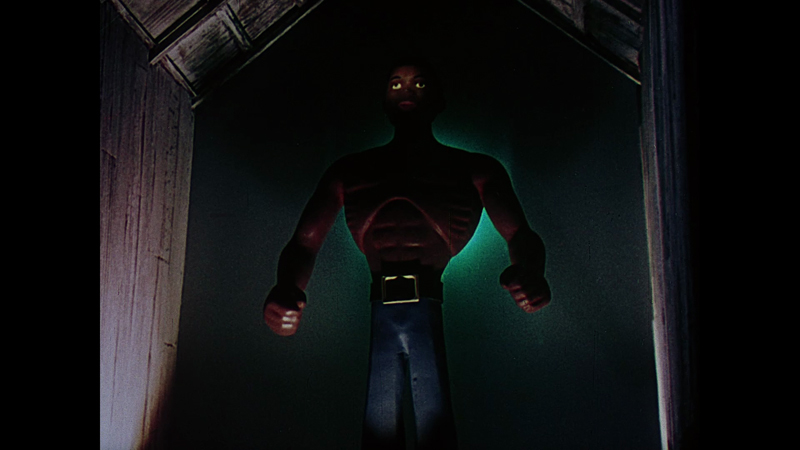
The Bottom Line
This is a truly great collection, covering Pal's contributions to film in tributes and his own work, with three complete features, an impressive collection of shorts and a host of wonderful archival material. While the quality isn't consistent, the heights reached and the sheer amount of content included make this set well worth the elevated price its niche status demands (especially when compared to the cost of the out-of-print DVDs.) Animation buffs shouldn't hesitate to add this to their collections, whether well-versed in Pal ot new to his work.
Francis Rizzo III is a native Long Islander, where he works in academia. In his spare time, he enjoys watching hockey, writing and spending time with his wife, daughter and puppy.Follow him on Twitter
*The Reviewer's Bias section is an attempt to help readers use the review to its best effect. By knowing where the reviewer's biases lie on the film's subject matter, one can read the review with the right mindset.
|
| Popular Reviews |
| Sponsored Links |
|
|
| Sponsored Links |
|
|
| Release List | Reviews | Shop | Newsletter | Forum | DVD Giveaways | Blu-Ray | Advertise |
|
Copyright 2024 DVDTalk.com All Rights Reserved. Legal Info, Privacy Policy, Terms of Use,
Manage Preferences,
Your Privacy Choices | |||||||









